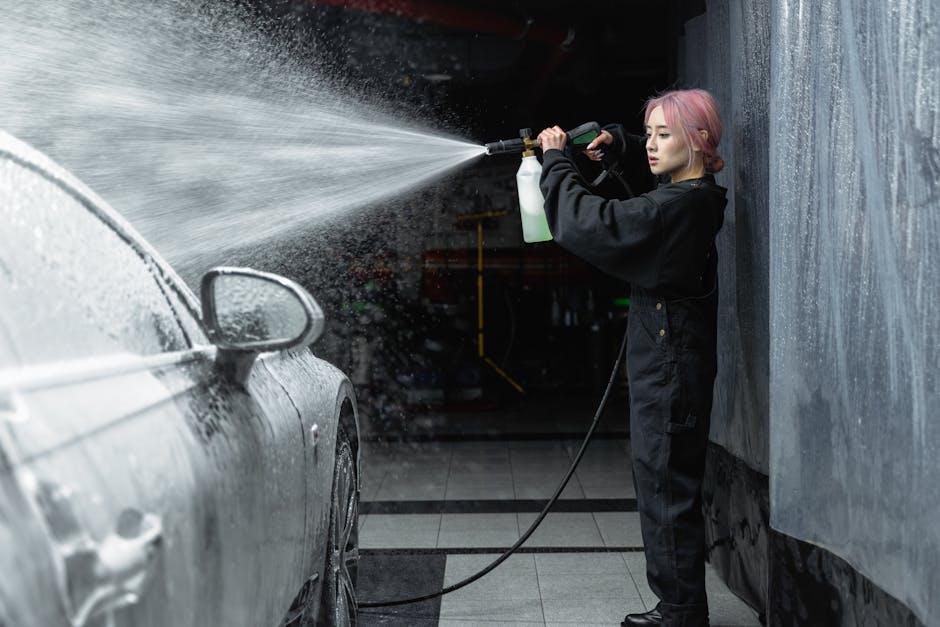In the intricate dance between metal and road, where precision and safety intersect, brake fluid often plays the unsung hero. Invisible yet indispensable, this liquid marvel ensures that the simple press of a pedal translates into reliable stopping power. Yet, like the finest instruments, it demands care and attention. Understanding the importance of brake fluid maintenance unveils a crucial chapter in vehicle safety—one where neglect can lead to costly consequences, and diligence can mean the difference between control and calamity. This article delves into why maintaining your brake fluid is not just a matter of routine but a pivotal aspect of responsible driving.
Table of Contents
- The Role of Brake Fluid in Vehicle Safety
- Understanding Brake Fluid Types and Their Compatibility
- Common Signs Your Brake Fluid Needs Attention
- Step-by-Step Guide to Checking and Replacing Brake Fluid
- Preventing Brake System Corrosion Through Proper Fluid Maintenance
- Expert Tips for Extending the Lifespan of Brake Fluid
- Q&A
- Insights and Conclusions

The Role of Brake Fluid in Vehicle Safety
Brake fluid is more than just a liquid inside your vehicle’s braking system; it acts as the lifeline that translates your foot’s pressure on the brake pedal into the immediate stopping power crucial for safety. This hydraulic fluid ensures seamless force transfer without compressing, allowing every millisecond of your reaction time to count. Without the proper level and quality of brake fluid, the braking system’s efficiency decreases, leading to longer stopping distances or even brake failure in critical moments.
Maintaining brake fluid involves keeping an eye on several key factors that directly influence your vehicle’s braking performance:
- Boiling Point: Old or contaminated brake fluid has a lower boiling point, increasing the risk of vapor lock during intense braking.
- Moisture Absorption: Brake fluid is hygroscopic, meaning it absorbs moisture from the air, which can corrode brake components and reduce reliability.
- Fluid Level: Low brake fluid levels can indicate leaks or worn brake pads, jeopardizing safety.
| Brake Fluid Type | Typical Boiling Point (Wet/Dry) | Change Interval |
|---|---|---|
| DOT 3 | 140°C / 205°C | Every 2 years |
| DOT 4 | 155°C / 230°C | Every 1-2 years |
| DOT 5 (Silicone) | 180°C / 260°C | Every 3-4 years |

Understanding Brake Fluid Types and Their Compatibility
Brake fluids are not all created equal, and selecting the right type is crucial for your vehicle’s safety and performance. Common types include DOT 3, DOT 4, and DOT 5.1, each with distinct chemical compositions and boiling points. For instance, DOT 3 and DOT 4 are glycol-based and compatible, but DOT 5 is silicone-based and should not be mixed with others. Using incompatible fluids can lead to system damage or brake failure, highlighting the importance of understanding compatibility before topping up or changing your brake fluid.
Below is a quick reference table illustrating key characteristics and compatibility of common brake fluids:
| Brake Fluid Type | Base Composition | Boiling Point (°C) | Compatibility |
|---|---|---|---|
| DOT 3 | Glycol | 205 (dry) | Compatible with DOT 4 & DOT 5.1 |
| DOT 4 | Glycol | 230 (dry) | Compatible with DOT 3 & DOT 5.1 |
| DOT 5 | Silicone | 260 (dry) | Not compatible with glycol types |
| DOT 5.1 | Glycol | 270 (dry) | Compatible with DOT 3 & DOT 4 |
Always check your vehicle manufacturer’s specifications and never mix fluids indiscriminately. Proper maintenance not only ensures optimal braking performance but also extends the lifespan of the brake system components, saving you from costly repairs and enhancing overall driving safety.

Common Signs Your Brake Fluid Needs Attention
Keeping an eye on your vehicle’s brake fluid is crucial, as it acts like the lifeblood of your braking system. When it starts to lose its effectiveness, you might notice unusual symptoms that should never be ignored. These warning signs often sneak up quietly but can manifest as:
- Spongy or soft brake pedal: If the pedal feels less firm or sinks more than usual, it could be a sign that air or moisture has contaminated the brake fluid.
- Longer stopping distances: Increased effort or distance to bring your vehicle to a halt is a red flag indicating deteriorated fluid performance.
- Brake warning light illuminates: This could be an alert from the system indicating low or degraded brake fluid levels.
- Discolored or dirty fluid: Fresh brake fluid is usually clear or slightly amber — if it looks dark or murky, it’s time for a checkup.
Below is a quick reference table summarizing these signs and their possible causes to help you evaluate when your brake fluid might be crying out for attention:
| Symptom | Possible Cause |
|---|---|
| Soft pedal | Air in brake lines |
| Extended stopping distance | Brake fluid contamination |
| Warning light on | Low fluid level |
| Discolored fluid | Moisture build-up or aging |

Step-by-Step Guide to Checking and Replacing Brake Fluid
Begin by locating the brake fluid reservoir, usually found near the back of the engine bay, close to the driver’s side. Before opening the cap, thoroughly clean the area to prevent contaminants from entering the system. Use a clean rag to wipe around the cap and check the fluid level through the transparent reservoir. If the fluid appears dark or murky, this is a clear indication it’s time for a change. When handling brake fluid, always use the type specified in your vehicle’s manual, as using the wrong kind can affect braking performance and damage the system.
Once ready to replace, follow these essential steps to ensure safety and system integrity:
- Prepare the vehicle: Park on a flat surface and engage the parking brake.
- Drain old fluid: Use a brake bleeder kit or open the bleeder valves to remove old fluid from each brake line.
- Refill reservoir: Slowly pour fresh brake fluid to the recommended fill line.
- Bleed the brakes: Remove any air bubbles by firmly pumping the brake pedal while opening and closing the bleeder valves.
Maintaining clean and adequate brake fluid not only safeguards your braking efficiency but also prevents costly repairs and ensures peace of mind on every drive.

Preventing Brake System Corrosion Through Proper Fluid Maintenance
Brake fluid serves as the lifeblood of your vehicle’s braking system, transmitting force while resisting heat and moisture. However, over time, contaminants like water can seep into the fluid, accelerating oxidation and leading to internal corrosion of brake components. This subtle but persistent process weakens metal surfaces inside the master cylinder, calipers, and brake lines, compromising the system’s integrity and safety. Regular maintenance not only prevents this decay but also preserves the fluid’s optimal boiling point, ensuring smooth, responsive braking performance.
Adopting a consistent brake fluid maintenance routine involves more than just fluid replacement—it’s about protecting the entire braking ecosystem. Key reminders include:
- Use the manufacturer-recommended brake fluid type to avoid chemical incompatibilities.
- Flush and replace brake fluid every 2 years or as specified in your vehicle manual.
- Seal the reservoir tightly to minimize moisture absorption from humid air.
- Inspect brake lines and components regularly for early signs of corrosion or leaks.
| Corrosion Risk | Maintenance Action |
|---|---|
| Water contamination | Brake fluid flush |
| Rust on metal parts | Visual inspection & replacement |
| Reduced boiling point | Fluid change to maintain performance |

Expert Tips for Extending the Lifespan of Brake Fluid
Maintaining the quality of your brake fluid is essential for ensuring your vehicle’s braking system performs optimally under all conditions. Always use high-quality brake fluid that meets or exceeds your vehicle manufacturer’s specifications. This ensures compatibility and reduces the risk of corrosion or degradation. Additionally, it’s crucial to prevent moisture contamination by keeping the brake fluid container tightly sealed when not in use and avoiding exposure to humid environments.
Regular inspection is another cornerstone of prolonging brake fluid life. Look out for signs such as:
- Dark or cloudy fluid appearance
- Spongy or inconsistent brake pedal feel
- Corrosion around brake components
Incorporating a brake fluid flush into your vehicle’s service schedule every 2 years or as recommended by your manufacturer can dramatically extend the fluid’s lifespan and protect your braking system. Below is a quick reference chart for recommended brake fluid change intervals based on common vehicle types:
| Vehicle Type | Recommended Change Interval |
|---|---|
| Passenger Cars | Every 2 years |
| Light Trucks & SUVs | Every 18 months |
| Commercial Vehicles | Annually |
Q&A
Q&A: The Importance of Brake Fluid Maintenance
Q1: Why is brake fluid so crucial for vehicle safety?
A: Brake fluid is the lifeblood of your braking system. It transmits the force from your brake pedal directly to the brake pads, allowing your vehicle to stop efficiently. Without properly functioning brake fluid, your brakes can become spongy, less responsive, or even fail, putting you and others at risk.
Q2: How does brake fluid degrade over time?
A: Brake fluid naturally absorbs moisture from the air through tiny pores in the brake lines and reservoir. This moisture reduces the fluid’s boiling point, leading to vapor formation under heavy braking. Vapor compresses more than liquid, causing a soft or unresponsive brake pedal and reducing braking efficiency.
Q3: What are the signs that my brake fluid needs maintenance?
A: Some common signs include a soft or sinking brake pedal, longer stopping distances, a warning light on your dashboard, or visibly dark or dirty fluid in the brake fluid reservoir. Regular inspection can catch these symptoms early, ensuring your brakes remain reliable.
Q4: How often should brake fluid be changed?
A: Most manufacturers recommend changing brake fluid every 2 years or 30,000 miles, whichever comes first. However, this can vary depending on the type of fluid used and driving conditions. Consult your vehicle’s manual and a trusted mechanic for personalized advice.
Q5: Can I check the brake fluid myself?
A: Yes! You can visually inspect the brake fluid level and color through the translucent reservoir. Clean brake fluid is usually clear or light amber. However, avoid opening the reservoir unnecessarily, as this can introduce moisture. For a thorough check and flush, professional servicing is best.
Q6: What risks do I run by neglecting brake fluid maintenance?
A: Neglecting brake fluid maintenance can lead to brake failure, longer stopping distances, and costly repairs. In extreme cases, poor brake performance can cause accidents or leave you stranded. Keeping your brake fluid fresh ensures your safety and peace of mind.
Q7: Is all brake fluid the same?
A: No, there are different types of brake fluids—DOT3, DOT4, DOT5, and DOT5.1—each with distinct chemical properties and compatibility requirements. Using the wrong type can damage the braking system, so always use the brake fluid specified by your vehicle’s manufacturer.
Q8: How does climate affect brake fluid maintenance?
A: Humid or wet climates can accelerate moisture absorption in brake fluid, necessitating more frequent changes. Likewise, extreme temperature changes can impact fluid performance. If you live in such conditions, be extra vigilant with brake fluid health.
Q9: Can brake fluid maintenance improve brake performance?
A: Absolutely. Fresh brake fluid maintains optimal hydraulic pressure and responsiveness. Regular maintenance keeps braking sharp and reliable, which is crucial during emergency stops or demanding driving scenarios.
Q10: What’s the best way to ensure my brake fluid stays in top shape?
A: Regular inspections, timely fluid changes, and professional servicing are key. Treat brake fluid maintenance as a critical part of your vehicle’s care routine, just like oil changes or tire checks. Doing so protects your brakes—and your life.
Insights and Conclusions
In the grand choreography of driving, brake fluid often plays the unsung role—quietly ensuring each stop is as responsive as it needs to be. Neglecting its maintenance can turn this vital partner into a hidden hazard. By giving brake fluid the attention it deserves, you’re not just preserving your vehicle’s performance; you’re investing in your safety and peace of mind on every journey. After all, in the delicate dance between road and driver, every drop counts.

